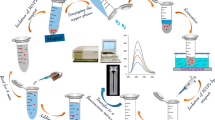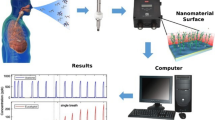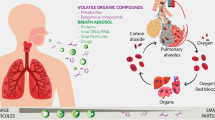Abstract
A fluorescent nanoprobe is designed for the determination of carbamazepine (CBZ) in exhaled breath condensate (EBC) of patients receiving CBZ. The probe consists of copper nanoclusters (Cu NCs) coated with cetyl trimethylammonium bromide. The interaction of probe with CBZ results in blocking non-radiative e−/h+ recombination defect sites on the surface of Cu NCs and consequently enhancing the blue-green fluorescence of Cu NCs (excitation/emission wavelengths: 290/480 nm). The experimental conditions were optimized using a response surface methodology (central composite design). Under the optimized conditions, the calibration plot is linear in the 0.2 to 20 μg mL−1 CBZ concentration range and the detection limit is as low as 0.08 μg mL−1. The intra-day and inter-day relative standard deviations for six replicated measurements of 10 μg mL−1 CBZ are 3.9% and 4.8%, respectively. The method was applied for the determination of CBZ level in EBC of patients receiving CBZ. The accuracy of the method was confirmed by HPLC-UV analysis as a reference method.

Schematic presentation of cetyl trimethylammonium bromide coated copper nanocluster's response to carbamazepine




Similar content being viewed by others
References
Duche P, Loiseau B (1995) Antiepileptic Drugs. In: Levy RH, Mattson RH, Meldrum BS, Penry JK, Dreyfuss FE (Eds.) 4th edn. Raven Press, New York, pp 555–560
Breton H, Cociglio M, Bressolle F, Peyriere H, Blayac JP, Hillaire-Buys D (2005) Liquid chromatography–electrospray mass spectrometry determination of carbamazepine, oxcarbazepine and eight of their metabolites in human plasma. J Chromatogr B 828:80–90
Deeb S, McKeown DA, Torrance HJ, Wylie FM, Logan BK, Scott KS (2014) Simultaneous analysis of 22 antiepileptic drugs in postmortem blood, serum and plasma using LC–MS-MS with a focus on their role in forensic cases. J Anal Toxicol 38:485–494
Kalhor H, Hashemipour S, Yaftian MR, Shahdousti P (2016) Determination of carbamazepine in formulation samples using dispersive liquid–liquid microextraction method followed by ion mobility spectrometry. Int J Ion Mobil Spectrom 19:51–56
Lin Y-Y, Wang C-C, Ho Y-H, Chen C-S, Wu S-M (2013) Analysis of carbamazepine and its five metabolites in serum by large-volume sample stacking–sweeping capillary electrophoresis. Anal Bioanal Chem 405:259–266
Ferreira A, Rodrigues M, Oliveira P, Francisco J, Fortuna A, Rosado L, Rosado P, Falcão A, Alves G (2014) Liquid chromatographic assay based on microextraction by packed sorbent for therapeutic drug monitoring of carbamazepine, lamotrigine, oxcarbazepine, phenobarbital, phenytoin and the active metabolites carbamazepine-10, 11-epoxide and licarbazepine. J Chromatogr B 971:20–29
Qu L, Fan Y, Wang W, Ma K, Yin Z (2016) Development, validation and clinical application of an online-SPE-LC-HRMS/MS for simultaneous quantification of phenobarbital, phenytoin, carbamazepine, and its active metabolite carbamazepine 10, 11-epoxide. Talanta 158:77–88
Burke J, Thenot J (1985) Determination of antiepileptic drugs. J Chromatogr B 340:199–241
Wang Y, Yan B, Chen L (2012) SERS tags: novel optical nanoprobes for bioanalysis. Chem Rev 113:1391–1428
Gill R, Zayats M, Willner I (2008) Semiconductor quantum dots for bioanalysis. Angew Chem Int Ed 47:7602–7625
Alivisatos P (2004) The use of nanocrystals in biological detection. Nat Biotechnol 22:47–52
Ma Y, Song Y, Ma Y, Wei F, Xu G, Cen Y, Shi M, Xu X, Hu Q (2018) N-doped carbon dots as a fluorescent probe for the sensitive and facile detection of carbamazepine based on the inner filter effect. New J Chem 42:8992–8997
Khoubnasabjafari M, Rahimpour E, Jouyban A (2018) Exhaled breath condensate as an alternative sample for drug monitoring. Bioanalysis 10:61–64
Hunt J (2002) Exhaled breath condensate: an evolving tool for noninvasive evaluation of lung disease. J Allergy Clin Immunol 110:28–34
Chow S, Yates D, Thomas P (2008) Reproducibility of exhaled breath condensate markers. Eur Respir J 32:1124–1126
De Paiva MJN, Menezes HC, De Lourdes Cardeal Z (2014) Sampling and analysis of metabolomes in biological fluids. Analyst 139:3683–3694
Effros RM, Biller J, Foss B, Hoagland K, Dunning MB, Castillo D, Bosbous M, Sun F, Shaker R (2003) A simple method for estimating respiratory solute dilution in exhaled breath condensates. Am J Respir Crit Care Med 168:1500–1505
Khoubnasabjafari M, Ansarin K, Jouyban-Gharamaleki V, Panahi-Azar V, Hamidi S, Azarmir Z, Jouyban A (2017) Methadone concentrations in exhaled breath condensate, serum and urine of patients under maintenance treatment. Iran. J Pharm Res 16:1621–1630
Jouyban A, Samadi A, Khoubnasabjafari M, Jouyban-Gharamaleki V, Ranjbar F (2017) Amidosulfonic acid-capped silver nanoparticles for the spectrophotometric determination of lamotrigine in exhaled breath condensate. Microchim Acta 184:2991–2998
Mohamadian E, Shayanfar A, Khoubnasabjafari M, Jouyban-Gharamaleki V, Ghaffary S, Jouyban A (2017) Analysis of deferiprone in exhaled breath condensate using silver nanoparticle-enhanced terbium fluorescence. Anal Methods 9:5640–5645
Ghosh SK, Rahman DS, Ali AL, Kalita A (2013) Surface plasmon tunability and emission sensitivity of ultrasmall fluorescent copper nanoclusters. Plasmonics 8:1457–1468
Jouyban A, Khoubnasabjafari M, Ansarin K, Jouyban-Gharamaleki V (2013) Breath sampling setup. Iranian Patent:81363
Karami-Bonari AR, Tamizi E, Samini M, Jabbaribar F, Jouyban A (2009) HPLC method for simultaneous determination of five antiepileptic drugs in rat plasma. Asian J Chem 21(8):6501–6507
Qu S, Chen H, Zheng X, Cao J, Liu X (2013) Ratiometric fluorescent nanosensor based on water soluble carbon nanodots with multiple sensing capacities. Nanoscale 5:5514–5518
Lim SY, Shen W, Gao Z (2015) Carbon quantum dots and their applications. Chem Soc Rev 44:362–381
Weller H (1993) Colloidal semiconductor q-particles: chemistry in the transition region between solid state and molecules. Angew Chem Int Ed Engl 32:41–53
Kamat PV (1993) Photochemistry on nonreactive and reactive (semiconductor) surfaces. Chem Rev 93:267–300
Isarov AV, Chrysochoos J (1997) Optical and photochemical properties of nonstoichiometric cadmium sulfide nanoparticles: surface modification with copper (II) ions. Langmuir 13:3142–3149
Fan L, Hu Y, Wang X, Zhang L, Li F, Han D, Li Z, Zhang Q, Wang Z, Niu L (2012) Fluorescence resonance energy transfer quenching at the surface of graphene quantum dots for ultrasensitive detection of TNT. Talanta 101:192–197
Bertilsson L, Tomson T (1986) Clinical pharmacokinetics and pharmacological effects of carbamazepine and carbamazepine-10, 11-epoxide, Clin. Pharmacokinet 11(3):177–198
Severus E, Fiebig J, Pfennig A, Bauer M (2018) Carbamazepine and valproic acid as mood stabilizers in the therapy of bipolar disorder. Is their use still justified? Psycopharmakotherapie 25:247–249
Rockville M (2007) The United States Pharmacopoeia 30, the National Formulary 25 US Pharmacopeial Convention, Electronic version
Acknowledgements
Research reported in this publication was supported by Elite Researcher Grant Committee under grant number 963572 from the National Institutes for Medical Research Development (NIMAD), Tehran, Iran.
Author information
Authors and Affiliations
Corresponding author
Ethics declarations
The author(s) declare that they have no competing interests.
Additional information
Publisher’s note
Springer Nature remains neutral with regard to jurisdictional claims in published maps and institutional affiliations.
Electronic supplementary material
ESM 1
(DOCX 233 kb)
Rights and permissions
About this article
Cite this article
Hatefi, A., Rahimpour, E., Khoubnasabjafari, M. et al. A single-shot diagnostic platform based on copper nanoclusters coated with cetyl trimethylammonium bromide for determination of carbamazepine in exhaled breath condensate. Microchim Acta 186, 194 (2019). https://doi.org/10.1007/s00604-019-3278-z
Received:
Accepted:
Published:
DOI: https://doi.org/10.1007/s00604-019-3278-z




